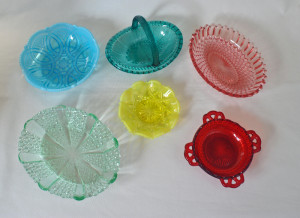What Is Pressed Glass?
The style of glassware known as pressed glass, or moulded glass, developed in the early 19th century when glassmaking changed from being a craft to being a factory-based process. In addition, glass in the United Kingdom had been taxed by weight, and this tax was repealed in 1845. It now became profitable to produce runs of identical moulded items, and the demand for domestic glassware grew. New ranges were produced each year and, as well as the traditional clear, or flint, glass, many other styles were developed, such as opaque, marbled, opalescent and coloured.
The procedure for moulding glass is to add molten glass to a plain or patterned mould and to press it into the mould with a plain or patterned plunger. The moulds were made from cast iron or brass, and later precision power-assisted tools became available to cut the patterns on the moulds.
The earliest styles were seen in the USA, France, Belgium, Bohemia and Sweden in the 1830’s.
The earliest known English example dates from 1836, but the industry really came into its own in the 1850s, the Victorian period. Major centres of glass making in England were in the North East and in the Manchester area. In fact, by the mid-1870s, Manchester works were producing around 120 tons a week, and Molineaux Webb and Percival Vickers were two of the largest manufacturers in the country.
The text of the pages is adapted from the books on the reading list.
The illustrations are of items in my collection, photographed by myself.
Any comments? Contact me at: murrayam @ supanet.com
(But don’t expect any technical answers – I’m not an expert. Read the books!)

If you are interested in all things English, visit English Weights & Measures for a full listing of the Imperial weights and measures system.